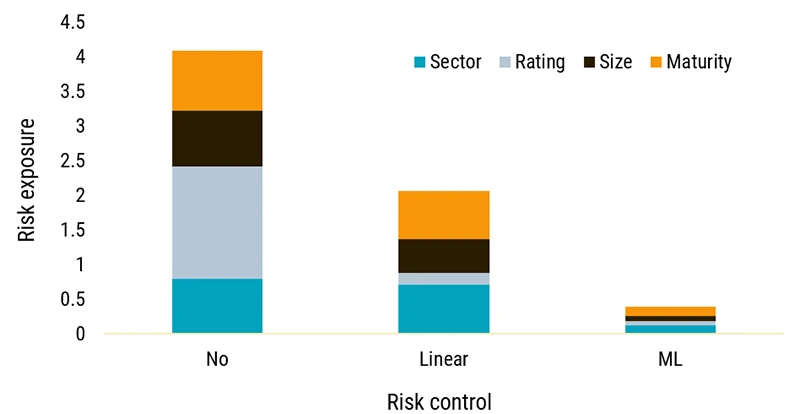In the equity market, a stock's valuation is often determined by comparing its market price to a fundamental anchor, such as the company's book value or earnings. Similarly, value investing in the credit market seeks to identify mispricings by determining whether a bond's credit spread adequately compensates for its risk.
A typical quantitative approach is to estimate the fair spread in a linear regression framework on credit spreads (Houweling and Van Zundert, 20171 ). The residual of the regression serves as a value measure, which is the difference between the estimated fair spread and the market spread. A large residual indicates that a bond is mispriced, while a small residual indicates that a bond is fairly priced.
Optimizing risk management with machine learning
However, linear regression models can’t handle more complex dependencies between risk measures (nonlinearities and interactions) easily, because the number of explanatory variables quickly becomes unmanageable. For example, five risk measures leads to ten interactions, but with ten risk measures, the number of interactions is already forty-five.
The idea is thus to use a model based on machine learning (ML), specifically so-called regression trees, to enhance the value factor. To better control for risk than traditional methods, regression trees can account for non-linearities and interaction effects, thereby reducing the bias toward riskier bonds and allowing investors to benefit more from true mispricings.
To see how successful the ML-based value factor is at reducing risk, we evaluate the exposures of the ML-based value factor to traditional corporate bond risks and compare it to a value factor with linear risk controls and a value factor with no controls.
Figure 1: Exposure to risk dimensions

Source: Robeco, 2024.
Why choose ML to control risk?
For all value factors, we measure the exposure to credit ratings, sectors, issuer size groups, and maturity groups for each month and aggregate the active exposures over time. A lower risk exposure score indicates that a value factor is better at controlling a given risk dimension. The figure shows that using linear risk controls reduces the risk by half compared to having no controls at all, demonstrating the importance of controlling risk.
The figure also shows that using ML-based risk controls reduces risk even more. This significant reduction in risk makes the ML-based value factor less vulnerable to systematic shocks and therefore less risky, clearly demonstrating the advantages of an ML-based approach over traditional value factors in credit. This is one of the reasons why we also use an ML-based value factor in our Quant Credit products, such as Multi-Factor Credits and Multi-Factor High Yield.
Further information can be found either in our paper “True Value Investing in Credits through Machine Learning” or in an article on our website.
Footnote
1Houweling, Patrick and Jeroen van Zundert. 2017. “Factor Investing in the Corporate Bond Market.” Financial Analysts Journal 73 (2): 100-115.
最新のインサイトを受け取る
投資に関する最新情報や専門家の分析を盛り込んだニュースレター(英文)を定期的にお届けします。
重要事項
当資料は情報提供を目的として、Robeco Institutional Asset Management B.V.が作成した英文資料、もしくはその英文資料をロベコ・ジャパン株式会社が翻訳したものです。資料中の個別の金融商品の売買の勧誘や推奨等を目的とするものではありません。記載された情報は十分信頼できるものであると考えておりますが、その正確性、完全性を保証するものではありません。意見や見通しはあくまで作成日における弊社の判断に基づくものであり、今後予告なしに変更されることがあります。運用状況、市場動向、意見等は、過去の一時点あるいは過去の一定期間についてのものであり、過去の実績は将来の運用成果を保証または示唆するものではありません。また、記載された投資方針・戦略等は全ての投資家の皆様に適合するとは限りません。当資料は法律、税務、会計面での助言の提供を意図するものではありません。 ご契約に際しては、必要に応じ専門家にご相談の上、最終的なご判断はお客様ご自身でなさるようお願い致します。 運用を行う資産の評価額は、組入有価証券等の価格、金融市場の相場や金利等の変動、及び組入有価証券の発行体の財務状況による信用力等の影響を受けて変動します。また、外貨建資産に投資する場合は為替変動の影響も受けます。運用によって生じた損益は、全て投資家の皆様に帰属します。したがって投資元本や一定の運用成果が保証されているものではなく、投資元本を上回る損失を被ることがあります。弊社が行う金融商品取引業に係る手数料または報酬は、締結される契約の種類や契約資産額により異なるため、当資料において記載せず別途ご提示させて頂く場合があります。具体的な手数料または報酬の金額・計算方法につきましては弊社担当者へお問合せください。 当資料及び記載されている情報、商品に関する権利は弊社に帰属します。したがって、弊社の書面による同意なくしてその全部もしくは一部を複製またはその他の方法で配布することはご遠慮ください。 商号等: ロベコ・ジャパン株式会社 金融商品取引業者 関東財務局長(金商)第2780号 加入協会: 一般社団法人 日本投資顧問業協会




















